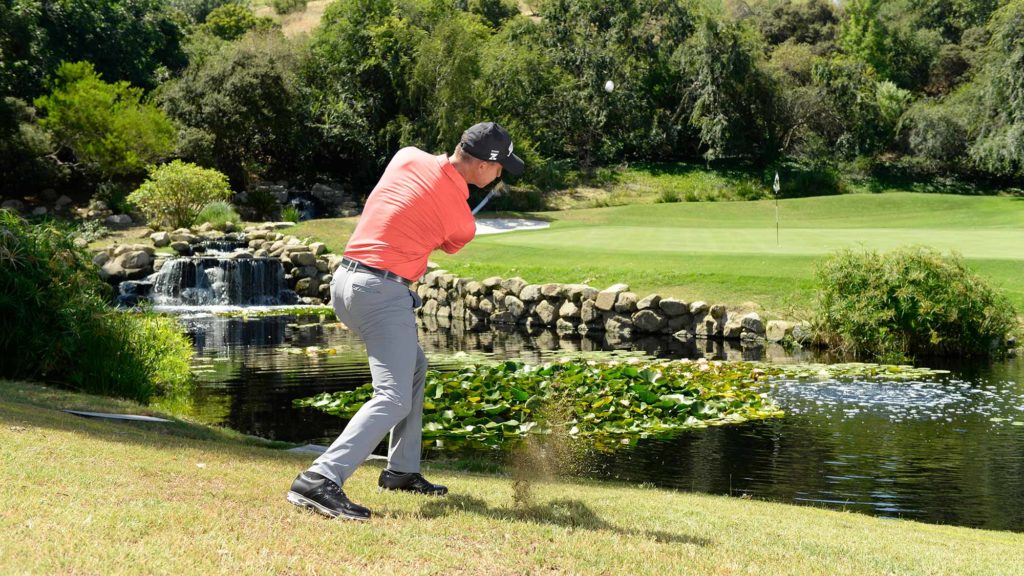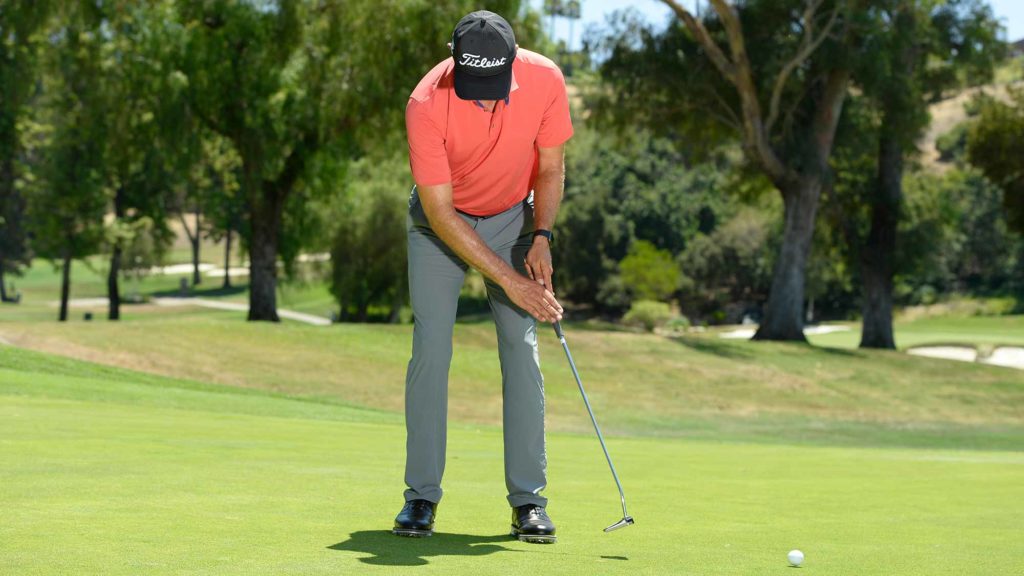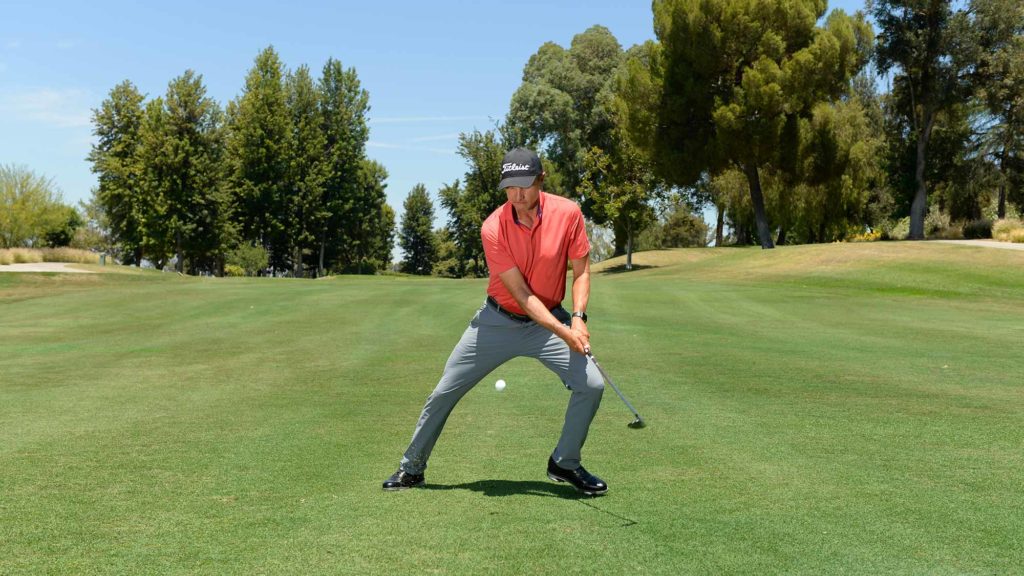They might be unnerving, but you can pull them off.
Imagine you have a big walk-in closet where you store all your golf skills. On the shelves and hangers you keep
your abilities to split a tight, tree-lined fairway with your driver, hit a long iron off a tight lie, and execute a downhill pitch over water – all the shots that make most amateurs feel uneasy. The only problem is, if you attempt to access one of those skills – but you’ve got strong doubt in your mind about pulling the shot off – that closet door is going to be locked. I’m sure you’ve experienced that feeling on the golf course where fear prevented you from swinging like you normally would. In this article, I’m going to help you face your trepidation of eight common scary shots. I’ll provide you with a swing tip to help your execution, and a swing thought that lets you access your skills closet. It’s natural to have negative thoughts when you play. We all do. You just have to know how to overcome them. – with Ron Kaspriske
1. Super-long rough
When you can’t afford to take an unplayable lie (featured image)
Sometimes you have no choice but to try to extricate your ball from a horrendous lie in long grass. Many golfers freeze when facing this lie, too worried they can’t get it out. To overcome that fear, focus on the process to hit this shot. You want to grab a wedge, open its face so it’s pointing skyward, and grip it as tightly as you can. Also try to
get on solid footing with your weight favouring your lead leg. To get your mind off airswinging, focus on swinging sharply down with firm wrists and let the heel of the club lead the way into impact. Keep your eyes on the ball the whole way down.

2. Narrow fairways
When you have to hit driver
Whether there’s a forced carry or you have to reach the green in regulation, sometimes you need to pull driver on tough holes for extra distance. My advice for these situations blends the mechanical with the psychological. Too often nerves make you tighten up and try to steer the ball into the fairway. But what you want is to make the most freewheeling swing you can. Sure, play the shot shape you’re most comfortable with, but you’ve got to let it fly. And here’s some reverse psychology: instead of thinking it’s a tight hole, imagine you’re about to drive it into the ocean. Just get up there and let it rip.

3. Tight lies
When it’s a middle or long iron with no cushion
Sometimes finding the fairway off the tee is bittersweet. Modern agronomy has made fairway grass shorter and firmer, and when you have no cushion for a longer approach shot, the lie can freak you out. Instead, think the opposite: you’ve actually got a terrific lie – clean access to the back of the ball. Now you can focus on making good contact. Take a few practice swings next to the ball, noting where the club bottoms out. Keep adjusting your stance until the low point of the swing is past the ball. Then step in and swing, making sure the club hits the turf after it strikes the ball.

4. Rough shots
When faced with a forced carry from the rough
Let’s do the maths. If you have to carry a penalty area or something similar from the rough, and you’re not sure you can do it, lay up. If you put it back in the fairway, you’re probably only going to sacrifice one shot, and one shot is easy to make up. But if you go for the green and fail, you’re likely going to add more than one shot to your score, sometimes a lot more. With that said, if you have to go for it, take one club longer than normal, open the face slightly, and set up with 70 percent of your weight on your lead foot. Then make a steeper swing into the ball. Focus only on solid contact.

5. Fairway bunkers
When you’re in the sand inside 100 metres
When facing a shorter fairway-bunker shot, a lot of amateurs tense up. They wonder if they’re supposed to play it like a greenside bunker shot or pick it clean. You definitely want to pick it clean. To do that, set up so the ball is close to the heel of your front foot, and the club’s shaft is leaning away from the target. The backward-leaning shaft will allow you to catch it on the upswing. Solid contact is the goal, so the key is stability. Imagine you’re standing on a frozen pond and any extraneous movement will make you slip and miss. Your goal is to clip the ball off the ice without shattering it.

6. Downhill lies
When you have to get the ball up
Any time amateurs have a forced carry, there’s always going to be some anxiety. But when the ball is on a downslope, things can get dicey. The mistake is to rise out of your address posture, trying to help the ball over the hazard with a little body-english. You can see here that I’ve maintained flex in my legs and made a very low-and-wide swing through the ball. The mental image that can help distract you from those nervous feelings is that the clubhead needs to land on an airport runway as it meets the ball. Let the clubhead continue along the runway after impact. Stay low to make the ball fly high.

7. Touchy shots
When you have to chip from the fringe to a close pin
Many amateurs make a short-and-fast stab at short chips, because they mistakenly think they have to accelerate through the ball. Not true. All you need is a smooth, pendulum-like putting tempo. In fact, I want you to pretend you’re putting. Grab a wedge, set up in a narrow stance, and make a stroke back and through like a putt, including the same length. Keep the elbows soft and follow through in an unrushed pace. For great contact, pretend there’s a drop of paint on the back of the ball and another on the centre of the clubface and connect the dots.

8. Slick putts
When you’re way above the hole
When many golfers are faced with the simplest task of just getting a putt started on the right line and letting gravity do the work, they get super stressed and wind up jabbing at the ball. There are two ways to make slick, downhill putts easier to hole – one physical, one mental. The physical adjustment is to grip way down on the handle. A shorter lever imparts less energy on the strike. The mental adjustment is to pretend you’re putting to a hole much closer than the actual hole. It might be only a few centimetres in front of you, but having that visual should keep you from jabbing the putt off the green.

Bonus tip
When you need to flop it
I love hitting flop shots. They look hard to execute, but they’re not – and you look cool doing it. Grab your lob wedge, open the face so it’s pointing to the sky, and lower the shaft at address so your hands are well below your belt line. When you swing, let the clubhead glide along the grass, keeping the shaft in line with your trail arm. There is very little wrist action. Just imagine that the clubhead is a thin piece of paper sliding under the bottom of the golf ball.
Josh Zander, a Golf Digest Teaching Professional, is at Stanford University Golf Course
in California.




